公共英语五级考试PETS5:阅读理解题型剖析
- 格式:docx
- 大小:18.18 KB
- 文档页数:3
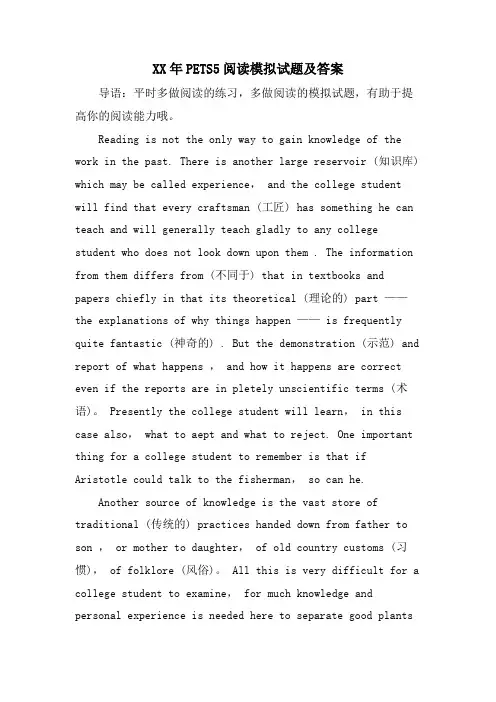
XX年PETS5阅读模拟试题及答案导语:平时多做阅读的练习,多做阅读的模拟试题,有助于提高你的阅读能力哦。
Reading is not the only way to gain knowledge of the work in the past. There is another large reservoir (知识库) which may be called experience, and the college student will find that every craftsman (工匠) has something he can teach and will generally teach gladly to any college student who does not look down upon them . The information from them differs from (不同于) that in textbooks and papers chiefly in that its theoretical (理论的) part ——the explanations of why things happen —— is frequently quite fantastic (神奇的) . But the demonstration (示范) and report of what happens , and how it happens are correct even if the reports are in pletely unscientific terms (术语)。
Presently the college student will learn, in this case also, what to aept and what to reject. One important thing for a college student to remember is that ifAristotle could talk to the fisherman, so can he.Another source of knowledge is the vast store of traditional (传统的) practices handed down from father to son , or mother to daughter, of old country customs (习惯), of folklore (风俗)。
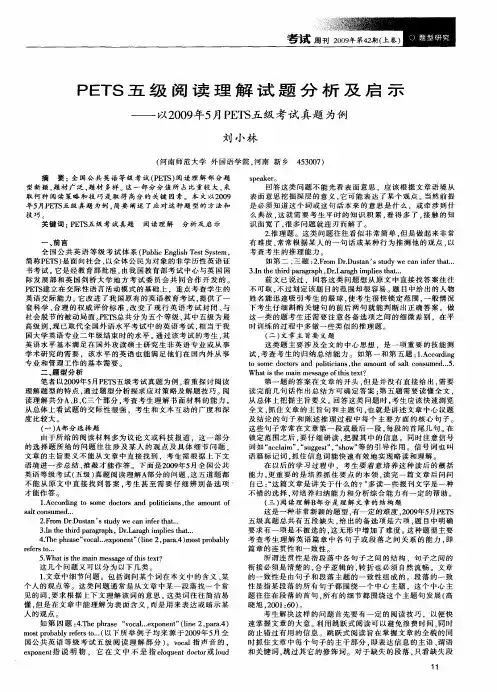
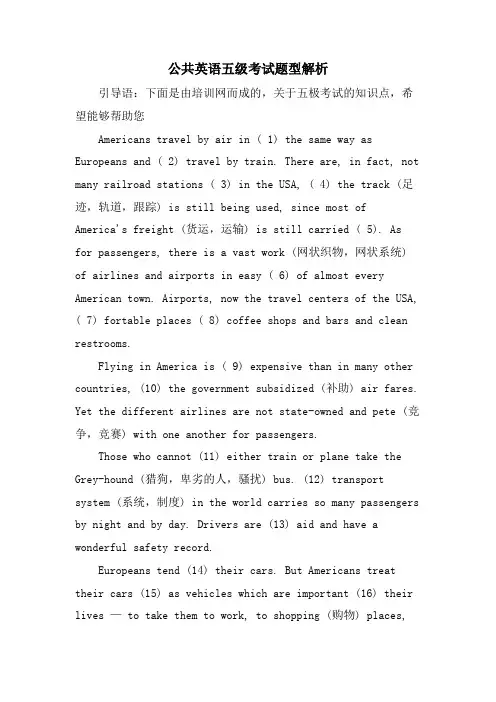
公共英语五级考试题型解析引导语:下面是由培训网而成的,关于五极考试的知识点,希望能够帮助您Americans travel by air in ( 1) the same way as Europeans and ( 2) travel by train. There are, in fact, not many railroad stations ( 3) in the USA, ( 4) the track (足迹,轨道,跟踪) is still being used, since most ofAmerica's freight (货运,运输) is still carried ( 5). Asfor passengers, there is a vast work (网状织物,网状系统) of airlines and airports in easy ( 6) of almost every American town. Airports, now the travel centers of the USA, ( 7) fortable places ( 8) coffee shops and bars and clean restrooms.Flying in America is ( 9) expensive than in many other countries, (10) the government subsidized (补助) air fares. Yet the different airlines are not state-owned and pete (竞争,竞赛) with one another for passengers.Those who cannot (11) either train or plane take the Grey-hound (猎狗,卑劣的人,骚扰) bus. (12) transport system (系统,制度) in the world carries so many passengers by night and by day. Drivers are (13) aid and have a wonderful safety record.Europeans tend (14) their cars. But Americans treat their cars (15) as vehicles which are important (16) their lives — to take them to work, to shopping (购物) places,to piics or to their friends. (17) when they take a vacation they rarely (稀少地,难得地) drive long distances.There is (18) form of travel which is widely used in the USA, — the rented car. Every city and town (19) at least one car rented firm (公司), some of them are nationwide and have branches abroad (20).1.all more as much2.Japaneses the Japanese the Japan Japans3.kept remained left remaining4.for when although because5.by train on train in train with train6.reach grasp (抓紧,领会) master range7.is are have been has been8.beside by with have9.most more less least10.if because of when because11.offer take reach afford12.All None No Every13.more greatly highly wonderfully14.to love to loving to be loving loving15.really only actually usually16.for to with on17.Except Because Besides /18.other another the other some other19.has had have has have had20.other countries either also as well参考答案:1-10 DBCCA ABCCD 11-20 DCCAB BABCDThe most obvious purpose of advertising is to inform the consumer of available products or services.The second (31)is to sell the product.The second purpose might be more important to the manufacturers than the (32) .The manufacturers go beyond only telling consumers about their products.They also try to persuade customers to buy the(33) by creating a desire(34) it.Because of advertisement,consumers think that they want something that they do not need.After buying somethin9,the purchaser cannot always explain why it was(35) .Even(36) —the purchaser probably does not know why he or she bought something,the manufacturers(37) .Manufacturers have analyzed the business of(38) and buyin9.They know all the different motives that influence a consumer’s purchase--some rational and(39)emotional.Furthermore,they take advantage of this(40) .Why(41) so many products displayed at the checkout counters in grocery stores? The store management has some good(42) .By the time the customer is(43) to pay for a purchase,he or she has already made rational,thought—out decisions(44) what he or she needs and wants to buy.The(45) feels that he or she has done a good job of choosing the items.The shopper is especially vulnerable at thispoint.The(46) of candy,chewing gum,and magazines are very attractive.They persuade the purchaser to buy something for emotional,not(47) motives.For example,the customer neither needs nor plans to buy candy.but while the customer is standing,waiting to pay money,he or she may suddenly decide to buy(48) .This is exactly(49) the store and the manufacturer hope that the customer will(50) .The customer follows his or her plan.答案及解析:31.purpose 【解析】从文中的第一句话“The most obvious purpose...”可以看出后面还有别的目的,而不是仅仅有最明显的目的。
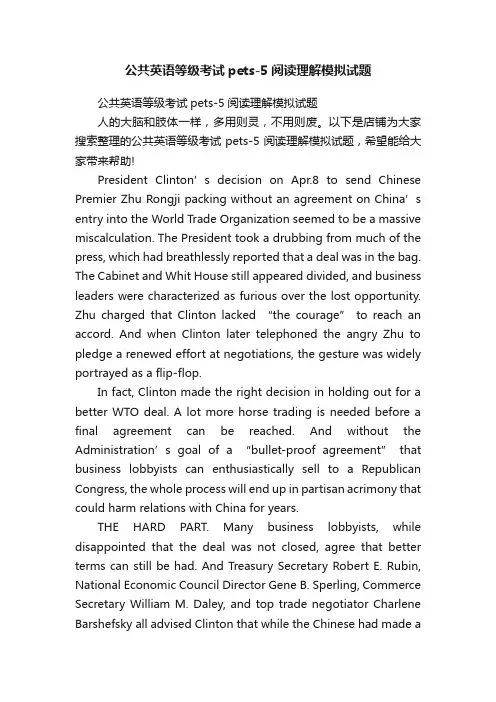
公共英语等级考试pets-5阅读理解模拟试题公共英语等级考试pets-5阅读理解模拟试题人的大脑和肢体一样,多用则灵,不用则废。
以下是店铺为大家搜索整理的公共英语等级考试pets-5阅读理解模拟试题,希望能给大家带来帮助!President Clinton’s decision on Apr.8 to send Chinese Premier Zhu Rongji packing without an agreement on China’s entry into the World Trade Organization seemed to be a massive miscalculation. The President took a drubbing from much of the press, which had breathlessly reported that a deal was in the bag. The Cabinet and Whit House still appeared divided, and business leaders were characterized as furious over the lost opportunity. Zhu charged that Clinton lacked “the courage” to reach an accord. And when Clinton later telephoned the angry Zhu to pledge a renewed effort at negotiations, the gesture was widely portrayed as a flip-flop.In fact, Clinton made the right decision in holding out for a better WTO deal. A lot more horse trading is needed before a final agreement can be reached. And without the Administration’s goal of a “bullet-proof agreement” that business lobbyists can enthusiastically sell to a Republican Congress, the whole process will end up in partisan acrimony that could harm relations with China for years.THE HARD PART. Many business lobbyists, while disappointed that the deal was not closed, agree that better terms can still be had. And Treasury Secretary Robert E. Rubin, National Economic Council Director Gene B. Sperling, Commerce Secretary William M. Daley, and top trade negotiator Charlene Barshefsky all advised Clinton that while the Chinese had made aremarkable number of concessions, “we’re not there yet,” according to senior officials.Negotiating with Zhu over the remaining issues may be the easy part. Although Clinton can signal U.S. approval for China’s entry into the WTO himself, he needs Congress to grant Beijing permanent most-favored-nation status as part of a broad trade accord. And the temptation for meddling on Capital Hill may prove over-whelming. Zhu had barely landed before Senate Majority Leader Trent Lott (R-Miss) declared himself skeptical that China deserved entry into the WTO. And Senators Jesse A. Helms (R-N.C.) and Emest F. Hollings (D-S. C.) promised to introduce a bill requiring congressional approval of any deal.The hidden message from these three textile-state Southerners: Get more protection for the U. S. clothing industry. Hoping to smooth the way, the Administration tried, but failed, to budge Zhu on textiles. Also left in the lurch: Wall Street, Hollywood, and Detroit. Zhu refused to open up much of the lucrative Chinese securities market and insisted on “cultural” restrictions on American movies and music. He also blocked efforts to allow U. S. auto makers to provide fleet financing.BIG JOB. Already, business lobbyists are blanketing Capitol Hill to presale any eventual agreement, but what they’ve heard so far isn’t encouraging. Republicans, including Lott, say that “the time just isn’t right” for the deal. Translation: We’re determined to make it look as if Clinton has capitulated to the Chinese and is ignoring human, religious, and labor rights violations; the theft of nuclear-weapons technology; and the sale of missile parts to America’s enemies. Beijing’s fierce critics within the Democratic Party, such as Senator Paul D. Wellstone of Minnesota and House Minority leader Richard A. Gephardt ofMissouri, won’t help, either.Just how tough the lobbying job on Capitol Hill will be become clear on Apr. 20, when Rubin lectured 19chief executives on the need to discipline their Republican allies. With business and the White House still trading charges over who is responsible for the defeat of fast-track trade negotiating legislation in 1997, working together won’t be easy. And Republicans-with a wink-say that they’ll eventually embrace China’s entry into the WTO as a favor to Corporate America. Though not long before they torture Clinton. But Zhu is out on a limb, and if Congress overdoes the criticism, he may be forced by domestic critics to renege. Business must make this much dear to both its GOP allies and the Whit House: This historic deal is too important to risk losing to any more partisan squabbling1. The main idea of this passage is[A]. The Contradiction between the Democratic Party and the Republican Party.[B]. On Chi na’s entry into WTO.[C]. Clinton was right.[D]. Business Lobbyists Control Capitol Hill.2. What does the sentence “Also left in the lurch: Wall Street, Hollywood, Detroit” convey?[A]. Premier Zhu rejected their requirements.[B]. The three places overdid criticism.[C]. They wanted more protection.[D]. They are in trouble.3. What was the attitude of the Republican Party toward China’s entry into the WTO?[A]. Contradictory. [B].Appreciative.[C]. Disapproving. [D]. Detestful.4. Who plays the leading part in the deal in America?[A]. White House . [B]. Republicans.[C]. The Democratic Party. [D]. Businessmen.5. It can be inferred from the passage that[A]. America will make concessions.[B]. America will hold out for a better WTO[C]. Clinton has the right to signal U. S. approval for China’s entry.[D]. Democratic party approve China’s entry into the WTO.Vocabulary1. drubbing 痛打get/take a drabbing 遭人痛打2. flip-flop=great change suddenly 游说,3. 突然改变,4. 突然反方向。
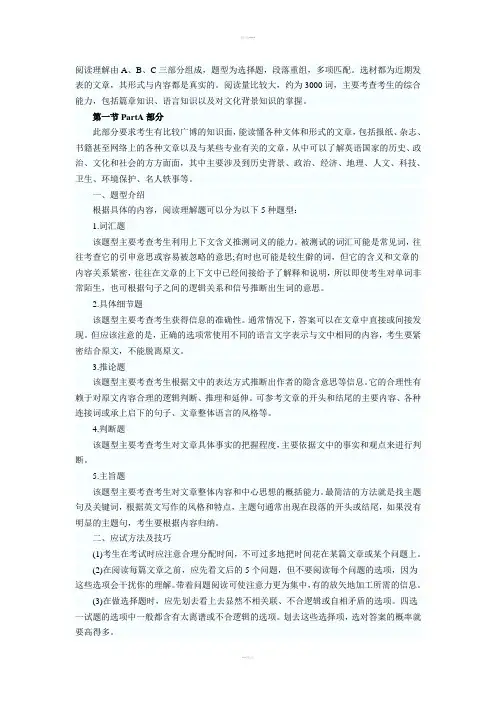
阅读理解由A、B、C三部分组成,题型为选择题,段落重组,多项匹配。
选材都为近期发表的文章,其形式与内容都是真实的。
阅读量比较大,约为3000词,主要考查考生的综合能力,包括篇章知识、语言知识以及对文化背景知识的掌握。
第一节PartA部分此部分要求考生有比较广博的知识面,能读懂各种文体和形式的文章,包括报纸、杂志、书籍甚至网络上的各种文章以及与某些专业有关的文章,从中可以了解英语国家的历史、政治、文化和社会的方方面面,其中主要涉及到历史背景、政治、经济、地理、人文、科技、卫生、环境保护、名人轶事等。
一、题型介绍根据具体的内容,阅读理解题可以分为以下5种题型:1.词汇题该题型主要考查考生利用上下文含义推测词义的能力。
被测试的词汇可能是常见词,往往考查它的引申意思或容易被忽略的意思;有时也可能是较生僻的词,但它的含义和文章的内容关系紧密,往往在文章的上下文中已经间接给予了解释和说明,所以即使考生对单词非常陌生,也可根据句子之间的逻辑关系和信号推断出生词的意思。
2.具体细节题该题型主要考查考生获得信息的准确性。
通常情况下,答案可以在文章中直接或间接发现。
但应该注意的是,正确的选项常使用不同的语言文字表示与文中相同的内容,考生要紧密结合原文,不能脱离原文。
3.推论题该题型主要考查考生根据文中的表达方式推断出作者的隐含意思等信息。
它的合理性有赖于对原文内容合理的逻辑判断、推理和延伸。
可参考文章的开头和结尾的主要内容、各种连接词或承上启下的句子、文章整体语言的风格等。
4.判断题该题型主要考查考生对文章具体事实的把握程度,主要依据文中的事实和观点来进行判断。
5.主旨题该题型主要考查考生对文章整体内容和中心思想的概括能力。
最简洁的方法就是找主题句及关键词,根据英文写作的风格和特点,主题句通常出现在段落的开头或结尾,如果没有明显的主题句,考生要根据内容归纳。
二、应试方法及技巧(1)考生在考试时应注意合理分配时间,不可过多地把时间花在某篇文章或某个问题上。
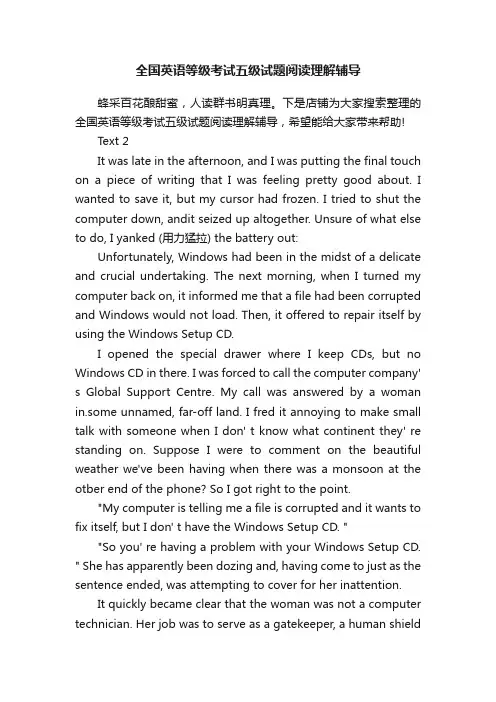
全国英语等级考试五级试题阅读理解辅导蜂采百花酿甜蜜,人读群书明真理。
下是店铺为大家搜索整理的全国英语等级考试五级试题阅读理解辅导,希望能给大家带来帮助!Text 2It was late in the afternoon, and I was putting the final touch on a piece of writing that I was feeling pretty good about. I wanted to save it, but my cursor had frozen. I tried to shut the computer down, andit seized up altogether. Unsure of what else to do, I yanked (用力猛拉) the battery out:Unfortunately, Windows had been in the midst of a delicate and crucial undertaking. The next morning, when I turned my computer back on, it informed me that a file had been corrupted and Windows would not load. Then, it offered to repair itself by using the Windows Setup CD.I opened the special drawer where I keep CDs, but no Windows CD in there. I was forced to call the computer company' s Global Support Centre. My call was answered by a woman in.some unnamed, far-off land. I fred it annoying to make small talk with someone when I don' t know what continent they' re standing on. Suppose I were to comment on the beautiful weather we've been having when there was a monsoon at the otber end of the phone? So I got right to the point."My computer is telling me a file is corrupted and it wants to fix itself, but I don' t have the Windows Setup CD. ""So you' re having a problem with your Windows Setup CD. " She has apparently been dozing and, having come to just as the sentence ended, was attempting to cover for her inattention.It quickly became clear that the woman was not a computer technician. Her job was to serve as a gatekeeper, a human shieldfor the technicians. Her sole duty, as far as I could tell, was to raise global stress levels.To make me disappear, the woman:gave me the phone number for Windows' creator, Microsoft. This is like giving someone the phone number for, I don' t know, North America. Besides, the CD worked; I just didn't have it. No matter how many times I repeated my story, we came back to the same place. She was calm and resolutely polite.When my voice hit a certain decibel (分贝), I was passed along, like a hot, irritable potato, to a technician."You don' t have the Windows Setup CD, ma' am, because you don' t need it, " he explained cheerfully."Windows came preinstalled on your computer!""But I do need it. ""Yes, but you don't have it. " We went on like this for a while. ,Finally, he offered to walk me through the use of a different CD, one that would erase my entire system. "Of course, you' d lose all your e-mail, your documents, your photos. " It was like offering to drop a safe on my head to cure my headache. "You might be able to recover them, but it would be expensive. " He sounded delighted. "And it' s not coveted by the warranty ( 产品保证书) !" The safe began to seem like a good idea, provided it was full.I hung up the phone and drove my computer to a small, friendly repair place I' d heard about. A smart, helpful man dug out a Windows CD and told me it wouldn't be a problem. An hour later, be called to let me know it was ready. I thanked him, and we chatted about the weather, which was the same outside my window as it was outside his.56. Why did the author shut down her computer abruptly?A. She had saved what she had written.B. She couldn't move the cursor.C. The computer refused to work.D. The computer offered to repair itself.57. Which of the following is the author' s opinion about the woman at the Global Support Centre?A. She sounded helpful and knowledgeable.B. She was there to make callers frustrated.C. She was able to solve her computer problem. ,D. She was quick to pass her along to a technician.58. According to the passage, the solution offered by the technician was __A. effectiveB. economicalC. unpracticalD. unacceptable59. "It was like offering to drop a safe on my head to cure my headache" in the last but one paragraph means thatA. the technician's proposal would make things even worseB. the technician' s proposal could eventually solve the problemC. files stored on her computer were like a safeD. erasing the entire system was like curing a headache60. It can be inferred from the passage that the differences between the Global Support Centre and the local repair shop lie in all the following EXCEPTA.efficiencyB. locationC. Setup CDsD. attitudeText2短文赏析本文讲述了作者在对自己认为非常满意的一篇文章收尾时,电脑出问题了,之后与全球技术支持中心的客服联络的.过程。
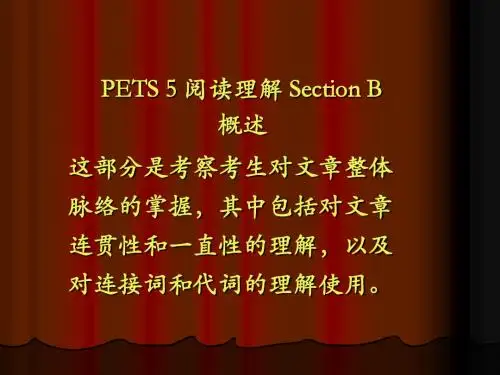
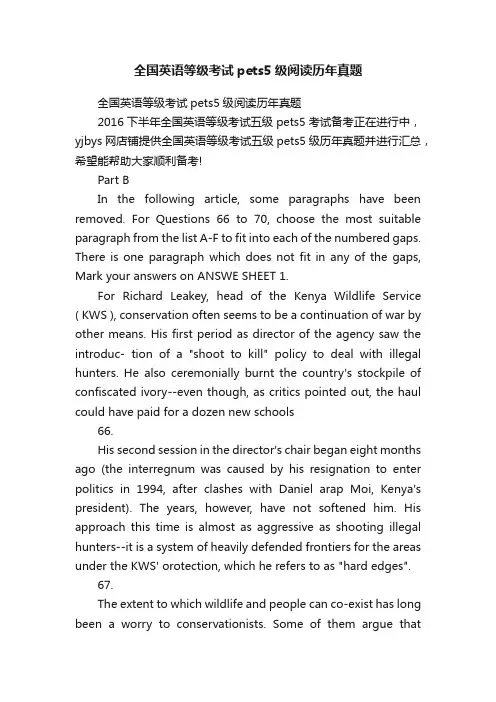
全国英语等级考试pets5级阅读历年真题全国英语等级考试pets5级阅读历年真题2016下半年全国英语等级考试五级pets5考试备考正在进行中,yjbys网店铺提供全国英语等级考试五级pets5级历年真题并进行汇总,希望能帮助大家顺利备考!Part BIn the following article, some paragraphs have been removed. For Questions 66 to 70, choose the most suitable paragraph from the list A-F to fit into each of the numbered gaps. There is one paragraph which does not fit in any of the gaps, Mark your answers on ANSWE SHEET 1.For Richard Leakey, head of the Kenya Wildlife Service ( KWS ), conservation often seems to be a continuation of war by other means. His first period as director of the agency saw the introduc- tion of a "shoot to kill" policy to deal with illegal hunters. He also ceremonially burnt the country's stockpile of confiscated ivory--even though, as critics pointed out, the haul could have paid for a dozen new schools66.His second session in the director's chair began eight months ago (the interregnum was caused by his resignation to enter politics in 1994, after clashes with Daniel arap Moi, Kenya's president). The years, however, have not softened him. His approach this time is almost as aggressive as shooting illegal hunters--it is a system of heavily defended frontiers for the areas under the KWS' orotection, which he refers to as "hard edges".67.The extent to which wildlife and people can co-exist has long been a worry to conservationists. Some of them argue thatpeaceful co-existence is possible, especially if the animals are made to pay their way through tourism and the "cropping" of surplus beasts to provide food. But others, though in general willing these days to fall in with the line that nature must earn its keep if it is to survive, suspect that the benefits will frequently accrue to people other than those whose activities actually threaten the animals--and thus that the invisible hand of self-interest will not give animals any pro- tection.68.The first place to be the target of this attitude is Lake Nakuru. It is surrounded by settlements, and its.boundaries have become "blurred" as a result. Now, thanks to a two-metre-high fence, those boundaries will be clear--and people who have been squatting on government land will have to leave.69.This valley is home to two rare species of monkey, the red colobus and the Tana River manga- bey. People have lived there since before it was declared a protected area, but their numbers have expanded considerably in recent years. One or other group of primates must, in Dr. Leakey's view, therefore go. He plans that it will be the people.The Tana River resettlement scheme is supposed to be voluntary, and comes with incentives such as money for new schools, water supplies and clinics.70.Whether "hard edges" will work as well as "shoot to kill" remains to be seen. But it could prove a risky strategy. People moved off their land have long memories, and when political circum- stances change they may translate those memories into action. Even in Europe, many of those whose homes have beenflooded by reservoirs still mourn their lost villages, and would go back giv- en the chance. And dams--with all the attitudes that back them up--are going out of fashion.A.But there are still some locals who would rather stay. In ——eory, they can. But they will have to put up with a series of restrictive measures designed to make life more comfortable for monkeys and less comfortable for people. Nobody, for instance, will be allowed to cut down trees; and human movements will be strictly controlled. The message is thus pretty clear: "please leave".B.Richard Leakey's second stint in charge of Kenya's wild animals looks likely to be as contro-versial as his first.C.Dr. Leakey seems to take the second approach--at least as far as the beasts in his custody are concerned. He is aware of the fact that his actions will be supported by the government only because of the income they bring to the tourist industry ( one of Kenya's biggest export earn- ers). And if it is to be an industrial project, then industrial public-policy methods should be applied.A western government, he points out, would not hesitate to use compulsory land purchase for a scheme deemed to be in the public interest (a hydroelectric dam, for exam- pie). So why should similar methods not apply to tourist-attraction wildlife reserves?D.That, though it will no doubt produce some complaints, is probably reasonable--the squatters should not have been there in the first place. More controversial, however, is a scheme to "encourage" people to leave the valley of the Tana River.E.Such harsh measures (backed, admittedly, by an international ban on all trade in ivory) ap- pear..to have worked. After decades of decline, the elephant population in Kenya has sta- bilised, and even begun to creep up again.F.This scheme means that Kenya's national parks are, in effect, declaring independence from the rest of the country. They will be surrounded by fences and defended by border guards. Those fences, which will often be electrified, will, of course, serve to keep the animals in and thus stop them damaging the crops on surrounding farms. But their main purpose is to keep unwanted humans out.Part B对于理查德·利基——肯尼亚野生动物保护局(KWS)的负责人来说,保护区往往是一种用另一种方式延续的战争。
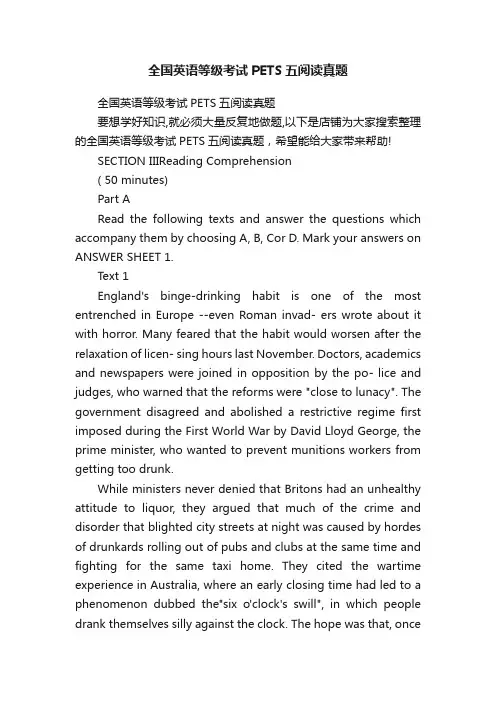
全国英语等级考试PETS五阅读真题全国英语等级考试PETS五阅读真题要想学好知识,就必须大量反复地做题,以下是店铺为大家搜索整理的全国英语等级考试PETS五阅读真题,希望能给大家带来帮助!SECTION IIIReading Comprehension( 50 minutes)Part ARead the following texts and answer the questions which accompany them by choosing A, B, Cor D. Mark your answers on ANSWER SHEET 1.Text 1England's binge-drinking habit is one of the most entrenched in Europe --even Roman invad- ers wrote about it with horror. Many feared that the habit would worsen after the relaxation of licen- sing hours last November. Doctors, academics and newspapers were joined in opposition by the po- lice and judges, who warned that the reforms were "close to lunacy". The government disagreed and abolished a restrictive regime first imposed during the First World War by David Lloyd George, the prime minister, who wanted to prevent munitions workers from getting too drunk.While ministers never denied that Britons had an unhealthy attitude to liquor, they argued that much of the crime and disorder that blighted city streets at night was caused by hordes of drunkards rolling out of pubs and clubs at the same time and fighting for the same taxi home. They cited the wartime experience in Australia, where an early closing time had led to a phenomenon dubbed the"six o'clock's swill", in which people drank themselves silly against the clock. The hope was that, oncehours were relaxed, Britons would adopt more civilised, continental habits, sipping delicately at glasses of Chablis rather than downing ten pints. Were the optimists or the pessimists right?Since the law was changed, around two-thirds of licensed premises have extended their open- ing times, most by an hour or so. (Fewer than 1 percent were granted a 24-hour licence. ) That smoothed the ]lp. m. and 2 a. m. chuck-out peaks and filled in some of the troughs. Local authori- ties in several large, lively cities, including Birmingham, Nottingham and Manchester, report that the streets are no more disorderly than before. One popular drinkers' street in Birmingham has seen a dramatic drop in crime (although that may also be because businesses, fearing the worst, paid for street wardens). In London, most strikingly, there has not been a single month since the drinking laws were relaxed when more violent crimes were recorded than in the same month a year earlier. That is also true in Westminster, where many of the capital's pubs and clubs are clustered. Overall levels of violence in the borough have fallen by 12 percent in the ten months since November 2005, compared with the same period a year before.The police remain cautious about such positive signs, saying it is still too early to tell what effect liberalisation will have on crime. They point out that local forces have diverted time and money to police late-night drinking, and have been given extra cash by the government. That will run out on Christmas Eve, at which point things may become trickier.In the meantime, pessimists are marshalling new, more ambitious arguments. Martin Plant of the University of the West of England maintains that freer drinking can lead to long-termproblems that are not immediately apparent. Iceland's capital, Reykjavik, softened drinking laws seven years ago. While policing became easier, more drunkards pitched up at hospital and drink-driving rates soared.51. The following statements are true EXCEPT thatA. the English indulgence in alcohol even horrified Roman invaders.B. the police and judges were in favor of the relaxation of licensing hours.C. the government did away with a law regulating drinking hours last year.D. World War I first saw the implementation of the law regulating drinking hours.52. Why did the government want to reform the drinking-hour restrictions?A. To follow the example of Australia.B. To change Britons' attitude to alcohol.C. To reduce the amount of alcohol consumed.D. To reduce crime rates caused by drinking.53. What happens now in big cities?A.Hordes of drunkards flood out of pubs at llp. m. and 2a.m.B. More licenses are granted to pubs and clubs.C. There are fewer criminal offences related to drinking.D. Things are different in London from other big cities.54. The police hold the view thatA. the changes are due to more police efforts rather than the reform.B. extension of drinking hours has produced a negative outcome.C. the government obscures the truth by providing extramoney.D. the success of the reform can only be guaranteed with more government input.55. Those who do not see a good prospect of the drinking reformA. are trying to find more effective solutions.B. are convinced that the reform will lead to more violent crimes.C. believe that there should be adequate medical service for the drunkards.D. believe that softened drinking laws may produce negative long-term effects.Text 2The best estimate of humanity's ecological footprint suggests that it now exceeds the Earth's re- generative capacity by around 20 percent. This fact is mentioned early on in the latest book from Lester R. Brown. The subtitle of Plan B 2.0 makes the bold claim of rescuing a planet under stress and a civilization in trouble. So will Brown's Plan B work?The green movement divides broadly into two camps technological optimists and social revolu- tionaries. For every person like Brown proposing new ways to produce protein, there is an indige- nous movement in a developing country struggling for land redistribution. Another divide is be- tween those who see the biggest environmental problem as population pressure in the developing South, and those who say it is'consumption patterns in the rich North. When push comes to shove, Brown qualifies as a technological optimist who is worried about population. The giveaway is his eulogy to green techno-fixes, coupled with the fear of fast-growing developing countriescopying Western consumer lifestyles.His optimism, though, appears forced as he rolls out a depressing litany of statistics describing species extinction, water shortage, economic upheaval resulting from the eventual decline of oil production and, of course, climate change. And his rescue plans? Shoehorned into Brown's book is a section headed "Eradicating poverty, stabilizing population". This relies heavily on the orthodox approach to human development that seeks to use aid to plug the income gap for poor countries. Enumerating the costs of attaining the United Nations' Millennium Development Goals on health,education and poverty reduction, Brown conveys a sense that a few new fiscal measures, combined with the goodwill of rich countries, will deliver. This is an approach that has been followed for the last three decades, and it has not worked. During the 1990s, the share of benefits from global eco- nomic growth reaching those living on less than a dollar a day fell by 73 percent, in spite of count- less p——omises to end poverty. This is the problem with Plan B 2.0.Brown's picture of climate-change-induced chaos is terrifying and convincing. It includes the awful image of the world's poorest people competing for food with an ever-hungrier bio-fuels indus- try, whose job will be to keep the developed world's SUVs on the road as oil becomes ever more expensive and then runs out. The combination of industrial inertia and the influence of industry on lobbyists is making this vision increasingly plausible. The poor get a bad deal because the world is run by the economic equivalent of gunboat diplomacy, as the recent World Tracie Organization talks showed.Technologically optimistic visions often have too much faith that change will flow from a ration- al discussion about sensiblepolicies, while tiptoeing around the real problems of power and politics. Even with Brown's Plan B to tell us which renewable energy technologies to use and which resilient food crops to grow, we are going to need a way to deal with economic vested interests and the demo- cratic deficit in global financial institutions that excludes the poor. For that, we need Plan C.56. What is the issue that Brown tries to address in his newly published book?[ A]The word's population has increased by 20 percent.B. Human activities have gone beyond what the earth is able to sustain.C. Human beings have developed in a certain ecological pattern.D. The green movement has failed to produce needed environmental changes.57. Brown believes that the spread of consumerism to less developed countries hasA. led to land shortage and redistribution.B. narrowed down the difference in lifestyle.C. contributed to environmental deterioration.D. increased high-protein food consumption.58. Talking about Brown's dismal picture of environmental degradation, the author thinks thatA. his optimism does not seem to be well-grounded.B. too many depressing statistics were listed in his book.C. his description of the environmental problems lacks a focus.D. he is trying to force his optimism on the readers.59. The phrase "gunboat diplomacy" ( line 6, para. 4) meansA. to deal with industrial relations in the automobile sector by way of lobbying.B. to threaten to use force to make a smallercountry agree to your demand.C. to negotiate within the WTO framework in dealing with bilateral relations. A. Because new sensible policies may bring about positive changes.B. Because the gap between the rich and poor should be narrowed.C. Because new technologies and crops can be introduced under this plan.D. Because the core problems of international politics should be addressed first.Text 3The average person sees tens of thousands of images a day--images on television, in news- papers and magazines, and on the sides of buses. Images also grace soda cans and T-shirts, and In- ternet search engines can instantly procure images for any word you type. On Flickr. com, a photo- sharing Web site, you can type in a word such as "love" and find photos of couples in embrace or parents hugging their children. Type in "terror", and among the results is a photograph of the World Trade Center towers burning. "Remember when this was a shocking image?" asks the per- son who posted the picture.The question is not merely rhetorical. It points to something important about images in our cul- ture: they have become less magical and less shocking. Until the development of mass reproduc- tion, images carried more power and evoked more fear.Today, anyone with a digital camera and a PC can produce and alter an image. As a result, the power of the image has been diluted in one sense, but strengthened in another. It has been dilu- ted by the ubiquity of images and the many populist technologies ( like inexpensive cameras and picture-editingsoftware) that give,almost everyone the power to create, distort, and transmit ima- ges. But it has been strengthened by the gradual surrender of the printed word to pictures. Text ce- ded to image might be likened to an articulate person being rendered mute, forced to communicate via gesture and expression rather than language.We love images and the democratizing power of technologies that give us the capability to make and manipulate images. What we are less eager to consider are the broader cultural effects of a society devoted to the image. Historians and anthropologists have explored the story of mankind's movement from an oral-based culture to a written culture, and later to a printed one. But in the past several decades we have begun to move from a culture based on the printed word to one based largely on images.In making images rather than texts our guide, are we opening up new vistas for understanding and expression, creating a new form of communication that is "better than print," as some scholars have argued? Or are we merely making a peculiar and unwelcome return to forms of communica- tion once ascendant in preliterate societies?Two things in particular are at stake in our contemporary confrontation with an image-based culture. First, technology has considerably undermined our ability to trust what we see, yet we have not adequately grappled with the effects of this on our notions of truth. Second, if we are in- deed moving from the era of the printed word to an era dominated by the image, what impact will this have on. culture? Will we become too easily accustomed to verisimilar rather than true things, preferring appearance to reality and in the process rejecting the demandsof discipline and patience that true things often require of us if we are to understand their meaning and describe it with preci- sion?61. The first paragraph of the text tells us thatA. we are exposed to a multitude of images every day.B. consumer goods with images look more graceful.C. the Internet can instantly present images of anything we want to buy.D. Internet search engines give us undesired and shocking images.62.With the development of mass reproduction, imagesA. have become le,ss important in popular culture.B. are not as impressive as they were to viewers.C. will be more magical and shocking in the future.D. will become more and more thought-provoking.63. The power of the image has been strengthened in the sense thatA. populist technologies enable almost everybody to manipulate images.B. images have gradually won popularity among common people.C. images are forcing us to communicate via gestures rather than language.D. with populist technologies, texts might give way to pictures gradually.64. What does "forms of communication once ascendant in preliterate societies" (line 4,para. 5) refer to?A.Images.B. Written words.C. Printed images.D. Texts.65. From the text, it can be inferred that the authorA. agrees that images offer a better form of communication than the print.B. does not share the opinion that an image-based culture is less advanced.C. shows deep concern about the impact of images on culture.D.prefers the image era to that of the printed word.SECTl0N IIIReading ComprehensionPartAText l在欧洲,英格兰的豪饮是最根深蒂固的习俗,甚至罗马侵略者都战战兢兢的对其进行了描述。
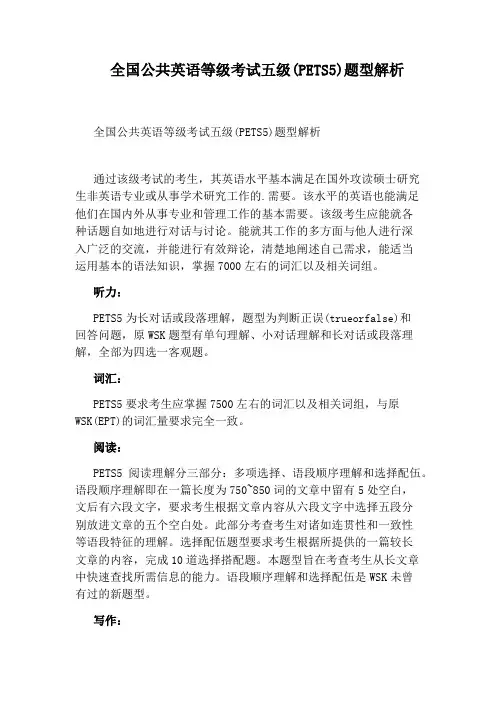
全国公共英语等级考试五级(PETS5)题型解析全国公共英语等级考试五级(PETS5)题型解析通过该级考试的考生,其英语水平基本满足在国外攻读硕士研究生非英语专业或从事学术研究工作的.需要。
该水平的英语也能满足他们在国内外从事专业和管理工作的基本需要。
该级考生应能就各种话题自如地进行对话与讨论。
能就其工作的多方面与他人进行深入广泛的交流,并能进行有效辩论,清楚地阐述自己需求,能适当运用基本的语法知识,掌握7000左右的词汇以及相关词组。
听力:PETS5为长对话或段落理解,题型为判断正误(trueorfalse)和回答问题,原WSK题型有单句理解、小对话理解和长对话或段落理解,全部为四选一客观题。
词汇:PETS5要求考生应掌握7500左右的词汇以及相关词组,与原WSK(EPT)的词汇量要求完全一致。
阅读:PETS5阅读理解分三部分:多项选择、语段顺序理解和选择配伍。
语段顺序理解即在一篇长度为750~850词的文章中留有5处空白,文后有六段文字,要求考生根据文章内容从六段文字中选择五段分别放进文章的五个空白处。
此部分考查考生对诸如连贯性和一致性等语段特征的理解。
选择配伍题型要求考生根据所提供的一篇较长文章的内容,完成10道选择搭配题。
本题型旨在考查考生从长文章中快速查找所需信息的能力。
语段顺序理解和选择配伍是WSK未曾有过的新题型。
写作:PETS5要求考生根据主题性或情景性提示写出一篇不少于250词的短文,类型除了一般性文章外还包括书信、科研论文、实验报告、申请材料等;而WSK是指导性作文(guidedwriting),要求按命题写出一篇不少于150个词的文章。
通过对比可以看出,PETS5比WSK写作要求高、难度大。
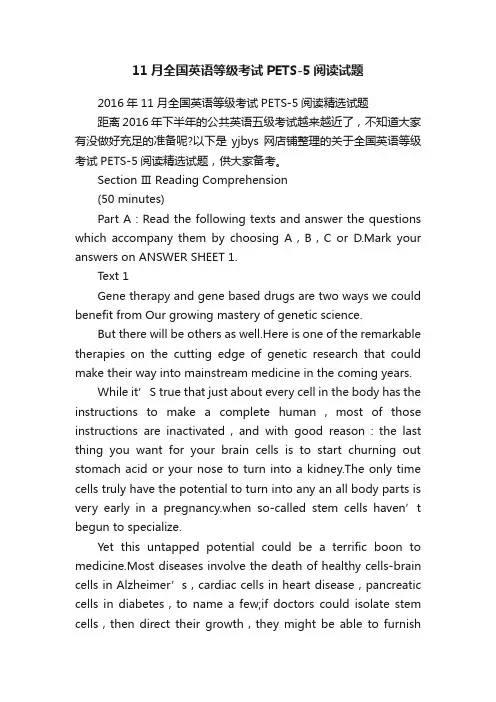
11月全国英语等级考试PETS-5阅读试题2016年11月全国英语等级考试PETS-5阅读精选试题距离2016年下半年的公共英语五级考试越来越近了,不知道大家有没做好充足的准备呢?以下是yjbys网店铺整理的关于全国英语等级考试PETS-5阅读精选试题,供大家备考。
Section Ⅲ Reading Comprehension(50 minutes)Part A:Read the following texts and answer the questions which accompany them by choosing A,B,C or D.Mark your answers on ANSWER SHEET 1.Text 1Gene therapy and gene based drugs are two ways we could benefit from Our growing mastery of genetic science.But there will be others as well.Here is one of the remarkable therapies on the cutting edge of genetic research that could make their way into mainstream medicine in the coming years.While it’S true that just about every cell in the body has the instructions to make a complete human,most of those instructions are inactivated,and with good reason:the last thing you want for your brain cells is to start churning out stomach acid or your nose to turn into a kidney.The only time cells truly have the potential to turn into any an all body parts is very early in a pregnancy.when so-called stem cells haven’t begun to specialize.Yet this untapped potential could be a terrific boon to medicine.Most diseases involve the death of healthy cells-brain cells in Alzheimer’s,cardiac cells in heart disease,pancreatic cells in diabetes,to name a few;if doctors could isolate stem cells,then direct their growth,they might be able to furnishpatients with healthy replacement tissue.It was incredibly difficult,but last fall scientists at the University of Wisconsin managed to isolate stem cells and get them to grow into neural,gut,muscle and bone cells.The process still can’t be controlled,and may have unforeseen limitations;but if efforts to understand and master stem cell development prove successful,doctors will have a therapeutic tool of incredible power.The sanle applies to cloning,which is really just the other side of the coin.True cloning,as first shown with the sheep Dolly two years ago,involves taking a developed cel and reactivating the genome within,resetting its developmental instructions to a pristine state.Once that happens,the rejuvenated cell can develop into a full—fiedged animal,genetically identical to its parent.For agriculture.in which purely physical characteristics like milk production in a cow or low fat in a hog have real market value,biological carbon copies could become routine within a few years.This past year scientists have done for mice and cows what Ian Wilmut did for Dolly,and other creatures are bound to join the cloned menagerie in the coming year.Human cloning,on the other hand,may be technically feasible but legally and emotionally more difficult.Still,one day it will happen.The ability to reset body cells to a pristine,undeveloped state could give doctors exact:ly the same advantages they would get from stem cells:the potential to make healthy body tissues of all sorts,and.thus to cure disease.That could prove to be a true“miracle cure”.51.The writer holds that the potential to make healthy bodytissues will_____.[A]aggravate moral issues of human cloning[B]bring great benefits to human beings[C]help scientists decode body instructions[D]involve employing surgical instruments52.The word“rejuvenated”(Para.5)m ost probably means_____.[A]modified[B]recoliccted[C]classified[D]reactivated53.The research at the University of Wisconsin is mentioned to show_____.[A]the isolation of stem cells[B]the effects of gene therapies[C]the advantages of human cloning[D]the limitations of tissue replacepmnts54.Which of the following is true according to the text?[A]The principle of gene therapy is applicable to that of cloning.[B]The isolation of stem ceils is too difficult to be feasible.[C]It is reasonable for all body instructions to be activated.[D]Cloned animals will eventually take control of the world.55.Towards the genetic research,the author’s attitude can best be said to be that of_____.[A] frustration[B]indifference[C]amazement[D]oppositionⅢ Reading Comprehension(共计35分。
英语等级考试pets五级阅读考试样题解析英语等级考试pets五级阅读考试样题解析difficult circumstanceserve aa textbook of life for people.以下是店铺为大家搜索整理英语等级考试pets五级阅读考试样题解析,希望能给大家带来帮助!A man once had a dream about the Black Forest in Germany. In his ( 1) he was walking in the forest ( 2) two men ran out and tried to throw him ( 3) the ground. He ran off as ( 4) as he could, ( 5) they immediately followed. He reached a place where he.( 6) two roads in front of him, one to the right and the other to the left. Which road should he ( 7)? He heard the two men behind him, ( 8) nearer and at the same time he heard ( 9) voice in his ears. It (10) him to go to the right, and he did so. He ran on and on and soon (11) to a small home, he was (12) there kindly and (13) a room to rest in, and so he was saved (14) the two men. That was the dream.Twenty years later he was (15) in the Black Forest and (16) happened in the dream long before, two men suddenly ran out (17) him. He ran and ran, and came to a place with two roads as in the dream. He (18) the dream and went to the (19). He soon reached a small house. And so he got rid of the two men. His dream of twenty years (20) had saved his life.1.way story (故事,新闻报道) experience dream2.which where when from which3.at over in to4.rapid quick soon fast5.then and butso6.searched watched saw had7.go lead pick take8.becoming running following getting9.a the his their10.persuaded warned stopped told11.entered went found got12.received met accepted settled13.taken given needed made14.with by from behind15.separately really once again16.like what that as17.across at towards for18.realize reminded remembered had19.right left house forest20.after ago laterbefore答案:DCDDC CDDADDABCB DBCAD。
英语等级考试公共英语五级试题阅读理解2017年英语等级考试公共英语五级试题阅读理解不渴望能够一跃千里,只希望每天能够前进一步。
以下是店铺为大家搜索整理的2017年英语等级考试公共英语五级试题阅读理解,希望能给大家带来帮助!Section 111 Reading Comprehension( 50 minutes)Part ARead the following texts and answer the questions which accompany., them by choosing A, B, C or D. Mark your answers on ANSWER SHEET 1.Text 1As long as her parents can remember, 13-year-old Katie Hart has been talking about going to college. Her mother, Tally, a financial-aid officer at a California University, knows all too well the daunting thing of paying for a college education. Last year the average yearly tuition at a private, four-year school climbed 5.5 percent to more than $17, 000. The Harts have started saving, and figure they can afford a public university without a problem. But what if Katie applies to Princeton ( she' s threatening), where one year' s tuition, room and board-almost $ 34, 000 in 2007-will cost more than some luxury cars? Even a number cruncher like Tally admits it' s a little scary, especially since she' 11 retire and Katie will go to college at around the same time.Paying for college has always been a hard endeavor. The good news: last year students collected $ 74 billion in financial aid, the most ever. Most families pay less than full freight. Sixty percent of public-university students and three quarters of those at private colleges receive some form of financial aid-mostly,these days, in the form of loans. But those numbers are not as encouraging as they appear for lower-income families, because schools are changing their formulas for distributing aid. Eager to boost their magazine rankings, which are based in part on the test scores of entering freshmen, they' re throwing more aid at smarter kids--whether they need it or not.The best way to prepare is to start saving early. A new law passed last year makes that easier for some families. So-called 529 plans allow parents to sock away funds in federal-tax-free-investment accounts, as long as the money is used for "qualified educaion expenses" like tuition, room and board. The plans aren' t for everyone. For tax reasons, some lower and middle income families may be better off choosing other investments. But saving is vital.When' s the best time to start? "Sometime, " says Jack Joyce of the College Board, "between the maternity ward and middle school. "Aid packages usually come in some combination of grants, loans and jobs. These days 60 percent of all aid comes in the form of low-interest loans. All students are eligible for "unsubsidized" federal Stafford loans, which let them defer interest payments until after graduation. Students who can demonstrate need can also qualify for federal Perkins loans or "subsidized" Staffords, where the government pays the interest during school. Fortunately, this is a borrower' s market. "Interest rates are at their lowest level in the history of student loans, " says Mark Kantrowitz, publisher of Finaid. Kantrowitz expects rates to fall even further when they' re reviewed this summer.Traditional scholarships, academic or athletic, are still a part of many families' planning. Mack Reiter, a 17-year-old nationalwrestling champion, gets so many recruiting letters he throws most away. He' 11 almost certainly get a free ride. Without it, "we would really be in a bind, " says his mother, Janet. For everyone else, it' s worth the effort to pick through' local .and national scholarship offerings, which can be found Ol—— Web sites like college-board, com.51. What does the author intend to illustrate with the example of the Harts?A. The difficulty of paying the tuition.B. The far-sight of the parents.C. The promising future of Katie.D. The increasing tuition in the university.52. What can we infer from the second paragraph?A. Some families are too poor to pay the full amount of the tuition.B. The parents do not favor the form of loans.C. Paying the tuition makes the parents feel humble.D. Those who are in great need may not get what they need.53. The last paragraph suggests that __A. many recruiting letters failed to provide Mack Reiter with scholarshipsB. Mack Reiter wanted to help his family go out of the troubleC. traditional scholarships are a good solution to the tuition problems in some familiesD. Mack Reiter was very proud of his national wrestling championship54. What does the author mean by "better off" ( Line 4, Paragraph 3 ) ?A. Richer.B. Wiser.C. Happier.D. Luckier.55. Which of the following is true according to the text?A. The Harts prefer a public university to a private one.B. It is much easier to pay the tuition at present.C. All students can get the aid package.D .Traditional scholarships are still attractive to some families.。
全国英语等级考试pets-5阅读历年真题全国英语等级考试pets-5阅读历年真题我们读书时,是别人在代替我们思想,我们只不过重复他的思想活动的过程而已,犹如儿童启蒙习字时,用笔按照教师以铅笔所写的笔画依样画葫芦一般。
我们的思想活动在读书时被免除了一大部分。
以下是店铺为大家搜索整理的全国英语等级考试pets-5阅读历年真题,希望能给大家带来帮助!Part CAnswer Questions 71 to 80 by referring to the 3 articles on juvenile delinquency. Answer each question by choosing A, B or C and mark it on ANSWER SHEET 1.Note: When more than one answer is required, these may be given in any order. Some choices may be required more than once.In which article(s) does (do) the author(s)provide the fact that countries vary in their concept of adulthood? 71.________mention that when dewing with juvenile delinquents,both the young offenders and society should be protected? 72._______ 73._______present the view that youngsters in the developed countries face the same situation as their counterparts do in the developing countries? 74._______explore the root of juvenile delinquency? 75._______suggest that some youngsters are taken as offenders for crimes they have never committed? 76._______advocate that children below a certain age should not be penalized for minor offences? 77._______say that the juvenile justice system should aim at helpingyoung people rather than simply punishing them? 78._______ 79.______tell the reader that attempts have been made to prevent delinquents from becoming hardened criminals? 80.________ AImpoverished young people experience society's linkage between poverty and crime from an early age. Many of them become involved with the police and the justice system simply because they appear poor or socially undesirable, or because they "look" dangerous--not because they have broken any law.People don't have to probe very far into the backgrounds of children who wind up in police stations and courtrooms to find a common denominator: poverty. In developing countries, poverty often forces children out of the house when they are as young as 10, sometimes even younger. They may never have had the opportunity to go to school, or may have attended irregularly or been"pushed" out, their performance hindered by hunger or distance from the school. Civil unrest may have forced them to flee their rural home for the city, where they arrived without papers and be- came separated from family members or friends.At any rate, these young people are probably living on the street, where destitution may lead them to steal from a shop, pick someone's pocket or barter the only thing they own--their bodies-- for survival.In the industrialized countries, many young people are surrounded by wealth but live in depri- vation, taunted by the unattainable riches of a consumer society. Growing up in neighborhoods where every corner has its drug dealer, and lacking the role model of grown-ups who go to legiti- mate jobs every morning, some find it impossible to resist the temptationof the drug trade's easy money. Eventually the police catch up with them. That is often the start of a life in which they know their probation officers better than their teachers.BAll countries have an age at which people become adults in the legal sense of the word--they can vote, sign legal contracts, marry. But the Convention on the Rights of the Child calls for coun- tries to establish a minimum age below which young people "shall be presumed not to have the ca- pacity to infringe the penal law"--in other words, an age below which they are too young to be re- sponsible for their actions and therefore too young to face criminal sanctions.But this age varies widely, and in many cases it is far too young : The age of criminal respon- sibility is 7 years in, for example, India, Ireland, Jordan, Nigeria, Pakistan, South Africa, Su- dan, Switzerland, Tanzania and Thailand. Under common law, the age is also 7 in most US states. A child barely old enough to go to school cannot possibly have the maturity to understand the consequences of his or her behaviour.Given that such young children can be subject to the penal code, it is all the more important that each country establish a humane and constructive juvenile justice system. Such a system is de- signed to deal with young offenders until they reach the age of adulthood. In an ideal world itserves as a safety net, catching children who commit petty offences and, instead of locking them away, helping them learn a sense of responsibility for their actions. The system should be based on knowledge of child development. At the same time, the juvenile justice system must protect society from potentially dangerous criminals.In many countries, a few brutal, highly publicized crimes by young people have led to public demands to lower the age at which children are held criminally responsible. Government leaders must resist the temptation to reduce the juvenile justice system to a structure for retribution designed for the rare hardened child criminal. Glib slogans like "Adult time for adult crime" betray the very people that society has failed and encourage "warehousing" of juveniles--in prisons that in reality serve as training grounds for criminals.CThere is no question that preventing crime is preferable to punishing it. Never is that more true than in the case of juvenile delinquency, so often a cry for help from a troubled youngster.The UN Guidelines for the Prevention of Juvenile Delinquency, known as the "Riyadh Guide- lines", recognize the importance of preventing young people from being stigmatized by the justice system. The Guidelines call for the development of measures that "avoid criminalizing and penali- zing a child for behaviour that does not cause serious damage to the development of the child or harm to others. " This statement sends a profound message: Preventing juvenile delinquency or crime is not just a matter of protecting society--its aim is to help children overcome their misdeeds and fulfill their potential. It is also less costly and more efficient for society to prevent young peo- ple from starting on criminal careers than to pay for the outcome of criminal behaviour.Many programmers have been established to help young people. In the Canadian province of Ontario, a Reasoning and Rehabilitation Project run by probation officers helps juveniles to modify impulsive behaviour and learn alternative responses tointerpersonal problems. Recidivism has fallen dramatically among the participants. In the Netherlands, Project HALT requires vandals to person- ally compensate their victims but in such a way that avoids stigmatizing them with the label of"criminal "..THAT IS THE END OF SECTION THREEDO NOT READ OR WORK ON THE NEXT SECTION UNTIL YOU ARE TOLD TOPart CA贫穷的年轻人从小就体会到了社会上贫穷和犯罪的联系。
2017年pets五级阅读考试题型解析训练有教养的头脑的第一个标志就是善于提问。
以下是小编为大家搜索整理的2017年pets五级阅读考试题型解析训练,希望能给大家带来帮助!更多精彩内容请及时关注我们应届毕业生考试网!Read the following text and fill each of the numbered spaces with ONE suitable word.Write your answers on ANSWER SHEET l.Pollution is a“dirty”word.To pollute means to contaminate-topsoil or something by introducing impurities which make(31) ___unfit or unclean to use.Pollution comes in many forms.We see it,smell it,(32) ___it,drink it,and stumble through it.We literally lived in and breathe pollution,and(33) ___surprisingly,it is beginning to(34) ___our health,our happiness,and our civilization.Once we thought of pollution(35) ___meaning simply the smog--the choking,stinging,dirty(36) ___that hovers over cities.But air pollution,while it is(37) ___the most dangerous,is only one type of contamination among several(38) ___attack the most basic life functions.Through the uncontrolled use of insecticides,man has polluted the land,(39) ___the wildlife.By(40) ___sewage and chemicals into rivers and lakes,we have contaminated our(41) ___water.We are polluting the oceans,too,killing the fish and(42) ___depriving ourselves(43) ___an invaluable food supply.Part of the problem is our exploding(44) ___.More and more people are producing more wastes.But this problem is intensified by our“throw—away”technology.Each year Americans(45) ___of 7 million autos,20 million tons of waste paper,25 million pounds of toothpaste tubes and 48 million cans.We throw away gum wrappers,newspapers,and paper plates.It is no longer wise to(46) ___anything.Today almost everything is disposable. (47) ___of repairing a toaster or a radi0,it is easier and cheaper to buy another one and discard the old,even(48) ___95 percent of its parts may still be functioning.Baby diapers,which used to be made of reusable cloth,are now paper throw-aways.Soon we will wear clothing made of(49) ___:“Wear it once and throw it away”will be the slogan of the fashionable consciousness.Where is this all to end? Are we turning the world into a gigantic dump,or is there hope that we can solve the pollution problem?(50) ___,solutions are in sight.A few of them are positively ingenious.参考译文污染是一个“肮脏”的词语。
阅读理解由A、B、C三部分组成,题型为选择题,段落重组,多项匹配。
选材都为近期发表的文章,其形式与内容都是真实的。
阅读量比较大,约为3000词,主要考查考生的综合能力,包括篇章知识、语言知识以及对文化背景知识的掌握。
第一节PartA部分
此部分要求考生有比较广博的知识面,能读懂各种文体和形式的文章,包括报纸、杂志、书籍甚至网络上的各种文章以及与某些专业有关的文章,从中可以了解英语国家的历史、政治、文化和社会的方方面面,其中主要涉及到历史背景、政治、经济、地理、人文、科技、卫生、环境保护、名人轶事等。
一、题型介绍
根据具体的内容,阅读理解题可以分为以下5种题型:
1.词汇题
该题型主要考查考生利用上下文含义推测词义的能力。
被测试的词汇可能是常见词,往往考查它的引申意思或容易被忽略的意思;有时也可能是较生僻的词,但它的含义和文章的内容关系紧密,往往在文章的上下文中已经间接给予了解释和说明,所以即使考生对单词非常陌生,也可根据句子之间的逻辑关系和信号推断出生词的意思。
2.具体细节题
该题型主要考查考生获得信息的准确性。
通常情况下,答案可以在文章中直接或间接发现。
但应该注意的是,正确的选项常使用不同的语言文字表示与文中相同的内容,考生要紧密结合原文,不能脱离原文。
3.推论题
该题型主要考查考生根据文中的表达方式推断出作者的隐含意思等信息。
它的合理性有赖于对原文内容合理的逻辑判断、推理和延伸。
可参考文章的开头和结尾的主要内容、各种连接词或承上启下的句子、文章整体语言的风格等。
4.判断题
该题型主要考查考生对文章具体事实的把握程度,主要依据文中的事实和观点来进行判断。
5.主旨题
该题型主要考查考生对文章整体内容和中心思想的概括能力。
最简洁的方法就是找主题句及关键词,根据英文写作的风格和特点,主题句通常出现在段落的开头或结尾,如果没有明显的主题句,考生要根据内容归纳。
二、应试方法及技巧
(1)考生在考试时应注意合理分配时间,不可过多地把时间花在某篇文章或某个问题上。
(2)在阅读每篇文章之前,应先看文后的5个问题,但不要阅读每个问题的选项,因为这些选项会干扰你的理解。
带着问题阅读可使注意力更为集中,有的放矢地加工所需的信息。
(3)在做选择题时,应先划去看上去显然不相关联、不合逻辑或自相矛盾的选项。
四选一试题的选项中一般都含有太离谱或不合逻辑的选项。
划去这些选择项,选对答案的概率就要高得多。
(4)应把一篇文章后的题目全部做完后再阅读下一篇文章。
若出现暂时无法肯定某题答
案的情况,可先依据材料及常识进行猜测,选取一个答案,同时在该答案旁边的空白处用铅笔打个问号,以便时间多余时可回过头来迅捷地找到该问题。
请注意,一定要回答所有的问题,因为即使猜错也是不扣分的。
(5)做词汇问题应注意以下3点:
①一个单词可有不同的意思,而选项常用与上下文语境不符的词义来迷惑考生。
②选项中有时会出现文章中的一个词或短语,由于这个词或短语与所考词汇相近,有可能被当做所考词汇的定义。
③还有一些选项由于拼写与所考词汇相似,易迷惑考生。
(6)回答主题类问题时可采用略读法,先读首段、末段及每个段落的第一个句子。
对于
这类问题应注意把握全文的内容,而不应以某个段落为依据做出选择。
选好答案后应看看它是否与文章中的每一段落都有联系。
若该选项与文中某一段落毫不相干,便表明选项不正确。
(7)回答有关文章细节的问题时可采取查读法。
在查读的同时,要默默地重复所寻找的
细节。
这种重复可加强视觉感知效果,更快捷、有效地找到所寻求的信息。
(8)回答推断性问题时考生应依据文章所讲的内容,利用推理的方法做出合理的选择。
这类问题难就难在考生无法直接从文章中找出考题的答案,而必须在完全理解文章的基础上,悟出其中隐含的意思。
回答这类问题时,往往需要利用常识、经验及文章中的观点和内容进行逻辑推理。
关联词、带有感情色彩的形容词或副词常常是一些有助于考生进行推理的语境线索。
(9)目的问题与主题问题关系密切。
但应试时,回答目的类问题的难度更大一些。
原因
在于考生必须选取一个通常在文章中找不到的答案。
作者的写作目的多种多样,常见的有提供信息、描述事件、陈述问题、讲述故事、进行规劝等。
(10)语气问题所指的语气是指作者在文章中直接表达的或者暗中流露出来的,对文章涉及的对象所持的态度和倾向性意见。
无论是直接表达还是间接流露,作者不是运用带有感情色彩的词汇或褒贬强烈的语句,就是依靠直接在文中插入作者的评语,甚至是一些讥讽嘲弄的口吻,来取得传达语气的预期效果。
回答这类问题,关键在于掌握一些语气词。
第二节PartB部分
考生需运用所掌握的阅读及写作的基本知识和技巧,充分利用文章中的话语标志、段落标志、文章结构、内容的逻辑关系使文章恢复原貌。
一、答题步骤
(1)先不要注意空缺部分,而是浏览主干部分,从而理清主干部分的脉络,找到文章的
主题,同时找到段落主题。
文章主题句或段落主题句也可能出现在but,however,rather,actually,moreover,likewise,inaddition等表转折或递进的词或短语后面。
(2)如果空缺不是单独成段,而是一段中的一部分,就要对含有空缺的各个段落仔细阅读,找到每段就段落主题展开的写作手法。
通常采用的写作手法有举例说明、罗列事实或步骤、类比或正反对比、反面论证以得到正面结论等。
尤其要注意空缺的上下旬,猜测空缺可
能的内容。
如果空缺单独成段,要注意空缺前后段的关系。
(3)就每个空缺检查答案,如果某一答案通过使用重复词、重复词组、同义词、对比结构、代词呼应、人称及数的一致等同此空缺上下文取得句子间的连贯性的话,此答案将可能是最佳选择。
或者当某一答案与上下文通过使用“步骤2”中提及的写作手法达到文章句子和段落主题的一致性时,此答案也可能是最佳选择。
二、应试技巧
该部分主要考查考生对诸如连贯性和一致性等语段特征的理解。
做这类题时,首先应把空缺5段文字的文章及后面的6段文字多读两遍,以了解整篇文章的概貌,并在此基础上剔除明显无法放入5个空缺处的那段文字。
其次,要了解文章的体裁,如在记叙文中作者常常按时间顺序叙述事件。
碰到这类文章,应留意分析表达时间概念的词汇。
另外,分析逻辑连接词也有助于完成这类题,因为在文章中段与段之间的联系有时通过逻辑连接词实现。
第三节PartC部分
考生通过阅读文章将问题与选项相匹配。
有时,同一个问题需要两个选项与其匹配。
这部分主要考查考生的阅读速度及搜寻信息的能力。
在答题时,考生需把握以下答题技巧:
(1)先把l0个题目多读几遍,抓住关键词,做到阅读文章之前对所有题目心中有数。
因为在这一节中,题目的先后顺序与文章中信息出现的先后顺序大多不一致。
若一个题目一个题目来做,势必低效费时。
(2)要快速阅读文章,理解句群的含义,大致把握文章的类型和结构并联系文章前面的l0个问题的关键词对3部分加以比较、对比,不必记住其他详细内容。
(3)可一边阅读,一边用铅笔将题号标在相关信息旁,以便读完文章后逐一核对题目及与之对应的信息。
(4)最后重新阅读文章前面的l0个问题,迅速准确地从文章中找到相关信息,完成提出的问题,但要注意有时答案并不是惟一的。